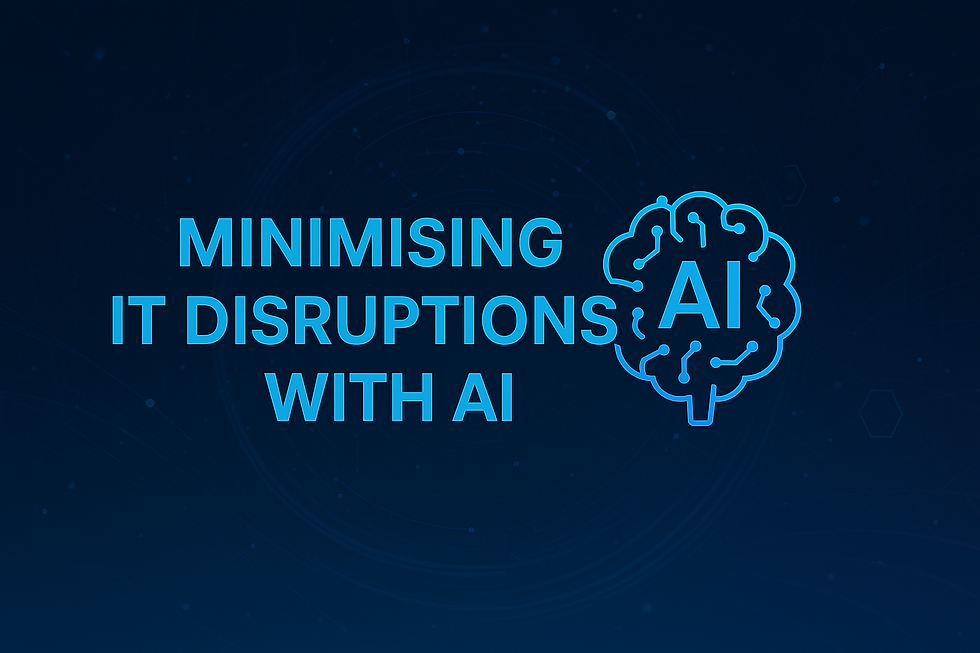Predictive Maintenance in Virtual Desktops: Minimising IT Disruptions with AI
- Art of Computing

- Sep 10
- 3 min read
Nothing kills productivity faster than a virtual desktop crash. You’re in the zone, working on a critical project, and suddenly everything freezes. By the time IT resolves the issue, you’ve lost momentum and wasted precious time. But what if crashes could be prevented before they happen? That’s where predictive maintenance powered by AI comes in. It’s like having a crystal ball for your IT infrastructure, spotting potential problems and fixing them before they disrupt your work.

What Is Predictive Maintenance?
Predictive maintenance uses AI to monitor virtual desktop environments in real-time, analysing data to identify patterns and predict potential issues. For example, if a server is showing signs of strain or a software update is causing instability, AI can flag the problem and take corrective action—often before users even notice.
This isn’t just about avoiding crashes. It’s about creating a more reliable and efficient workspace. A 2023 report by Gartner found that businesses using predictive maintenance reduced IT-related downtime by up to 50%. That’s a huge win for productivity and employee satisfaction.
How AI Predicts and Prevents Issues
Monitoring System PerformanceAI constantly tracks key metrics like CPU usage, memory consumption, and network latency. If something looks off—say, a sudden spike in resource usage—it can investigate and resolve the issue. For instance, if an application is hogging memory, AI might restart it or allocate additional resources to keep things running smoothly.
Identifying PatternsAI doesn’t just react to problems—it learns from them. By analysing historical data, it can identify patterns that lead to issues. For example, if a specific software update consistently causes instability, AI can flag it and recommend alternatives.
Automating FixesOne of the most powerful features of predictive maintenance is its ability to automate solutions. If a virtual desktop is running low on storage, AI can clear temporary files or move data to the cloud. If a server is overheating, it can redistribute workloads to prevent a crash.
Real-World Benefits for Businesses
The impact of predictive maintenance on businesses is significant. Here’s how it’s making a difference:
Reduced Downtime: A 2024 study by Forrester found that companies using AI-driven predictive maintenance saw a 40% reduction in unplanned downtime. That means fewer interruptions and more time spent on productive work.
Lower IT Costs: By preventing issues before they escalate, businesses can save on costly repairs and emergency support. The same study estimated that predictive maintenance could reduce IT operational costs by up to 30%.
Improved Employee Satisfaction: When virtual desktops run smoothly, employees are happier and more productive. A 2023 survey by PwC found that 65% of employees felt less stressed when using systems with predictive maintenance features.
IT Tips for Implementing Predictive Maintenance
If you’re considering predictive maintenance for your virtual desktop infrastructure, here are a few tips to get started:
Choose the Right Tools: Look for AI-powered solutions that integrate with your existing virtual desktop platform, such as Microsoft Azure or VMware Horizon.
Start Small: Pilot the technology with a specific team or department to see how it performs before rolling it out company-wide.
Train Your Team: Help IT staff understand how to use predictive maintenance tools and interpret their insights.
Monitor and Adjust: Regularly review the system’s performance and make adjustments as needed to ensure it’s meeting your goals.
The Future of Predictive Maintenance
The potential for AI in predictive maintenance is vast. As the technology evolves, we can expect even more advanced features, such as integration with IoT devices to monitor hardware health or real-time collaboration with AI agents to resolve complex issues.
A 2024 IDC report predicts that by 2026, 60% of enterprises will use AI for predictive maintenance in their IT infrastructure.
This isn’t just a trend—it’s becoming a standard for modern businesses.
Predictive maintenance is more than a tech upgrade—it’s a way to make work more reliable and less frustrating. By using AI to predict and prevent issues, businesses can reduce downtime, cut costs, and keep employees focused on what really matters. If you haven’t explored this yet, now’s the time to see how it can benefit your organisation.
Related Articles
What Is GPT-5 and How Does It Change AI’s Next Chapter – A look at the next generation of AI models and their impact.
Can AI Virtual Desktops Solve Remote IT Challenges? – How AI-driven virtual desktops reshape remote work security.
Are You Using AI at Work Yet? Don’t Let Your Business Fall Behind – Practical reasons businesses need to integrate AI today.




Comments